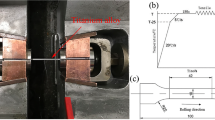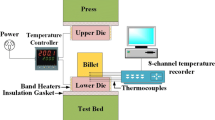Abstract
During the hot stamping process, heat exchange always occurs between the hot sheet and cold tools. The interfacial heat transfer in the whole-forming process will not only affects the forming quality of the parts but also partially determines their post-form mechanical properties and microstructure distribution. As an essential parameter, the interface heat transfer coefficient (IHTC) is of great significance for the prediction of temperature fields in the finite element simulations, especially for the novel-forming process named triple-layer sheet hot stamping. In this study, the triple-layer sheet heat exchange experiment is carried out to investigate the interfacial heat transfer behavior of the titanium alloy sheet in the triple-layer sheet hot stamping process. The effects of contact pressure, cladding steel sheet thickness, and contact gap on the interfacial heat transfer behavior and post-form mechanical properties of titanium alloy sheet are analyzed, and the interface heat transfer coefficient between the titanium alloy and high-strength steel sheets is calculated. The finite element model of triple-layer sheet heat transfer is established to verify the accuracy of the calculated interfacial heat transfer coefficient. The results show that the upper and lower steel sheets maintain the temperature of the titanium alloy sheets at a higher level in the triple-layer sheet hot stamping compared with the single-layer one. The temperature of the titanium alloy sheet under the single-layer hot stamping decreases from 900 to 781.6 °C after transferring, a decrease of 118.4 °C. The temperature of the titanium alloy sheet only declines by 57.5 °C during this period in the triple-layer sheet hot stamping process. In addition, the titanium alloy parts obtained by the triple-layer sheet hot stamping process have better mechanical properties. The IHTC increases with the increase of contact pressure and decreases with the increase of steel sheet thickness and contact gap. The accuracy of the calculated IHTC between the titanium alloy and cladding steel sheets is validated by comparing the results of the experiment and simulation. The maximum error between the simulation results and the experimental measurements is 5.5%.


















Similar content being viewed by others
Availability of data and materials
The datasets used or analyzed during the current study are available from the corresponding author on reasonable request.
Code availability
The code used or analyzed during the current study is available from the corresponding author on reasonable request.
References
Zhu YC, Zeng WD, Feng F, Sun Y, Han YF, Zhou YG (2011) Characterization of hot deformation behavior of as-cast TC21 titanium alloy using processing map. Mat Sci Eng A 528:1757–1763. https://doi.org/10.1016/j.msea.2010.11.015
Sirvin Q, Velay V, Bonnaire R, Penazzi L (2019) Mechanical behavior modelling and finite element simulation of simple part of Ti-6Al-4V sheet under hot/warm stamping conditions. J Manuf Process 38:472–482. https://doi.org/10.1016/j.jmapro.2018.12.010
Salishchev GA, Galeyev RM, Valiakhmetov OR, Safiullin RV, Lutfullin RY, Senkov ON, Froes FH, Kaibyshev OA (2001) Development of Ti-6Al-4V sheet with low temperature superplastic properties. J Mater Process Tech 116:265–268. https://doi.org/10.1016/S0924-0136(01)01037-8
Xiao J, Li D, Li X, Ding P, Zhao K, Huang X, Xu M (2015) Process parameters optimization of Ti-6Al-4V alloy sheet during hot stretch-creep forming. T Nonferr Metal Soc 25:420–428. https://doi.org/10.1016/S1003-6326(15)63619-6
Zong YY, Liu P, Guo B, Shan DB (2015) Springback evaluation in hot v-bending of Ti-6Al-4V alloy sheets. Int J Adv Manuf Technol 76:577–585. https://doi.org/10.1007/s00170-014-6190-z
Yang XM, Wang BY, Zhou J (2020) Numerical and experimental study on formability of TC4 alloy in a novel multi-layer sheet hot stamping process. Int J Adv Manuf Technol 110:1233–1247. https://doi.org/10.1007/s00170-020-05802-z
Caron EJFR, Daun KJ, Mary AW (2014) Experimental heat transfer coefficient measurements during hot forming die quenching of boron steel at high temperatures. Int Common Heat Mass Transfer 71:396–404. https://doi.org/10.1016/j.ijheatmasstransfer.2013.12.039
Ji K, Fakir OE, Gao HX, Wang LL (2015) Determination of heat transfer coefficient for hot stamping process. Mat Today Proc 2S:S434–S439. https://doi.org/10.1016/j.matpr.2015.05.059
Bai Q, Lin JG, Zhan L, Dean TA, Balint DS, Zhang Z (2012) An efficient closed-formed method for determining interfacial heat transfer coefficient in metal forming. Int J Mach Tools Manuf 56:102–110. https://doi.org/10.1016/j.ijmachtools.2011.12.005
Fieberg C, Kneer R (2008) Determination of thermal contact resistance from transient temperature measurements. Int Common Heat Mass Transfer 51:1017–1023. https://doi.org/10.1016/j.ijheatmasstransfer.2007.05.004
Nshama W, Jeswiet J, Oosthuizen PH (1994) Evaluation of temperature and heat transfer conditions at the metal forming interface. J Mater Process Tech 45:637–642. https://doi.org/10.1016/0924-0136(94)90411-1
Hu ZM, Brooks JW, Dean TA (1999) Experimental and theoretical analysis of deformation and microstructural evolution in the hot-die forging of titanium alloy aerofoil sections. J Mater Process Tech 88:251–265. https://doi.org/10.1016/S0924-0136(98)00407-5
Wilson WRD, Schmid SR, Liu J (2004) Advanced simulations for hot forging: heat transfer model for use with the finite element method. J Mater Process Tech 155–156:1912–1917. https://doi.org/10.1016/j.jmatprotec.2004.04.399
Xiao WC, Wang BY, Zheng KL, Zhou J, Lin JG (2018) A study of interfacial heat transfer and its effect on quenching when hot stamping AA7075. Arch Civil Mech Eng 18:723–730. https://doi.org/10.1016/j.acme.2017.12.001
Caron E, Daun KJ, Wells MA (2013) Experimental characterization of heat transfer coefficients during hot forming die quenching of boron steel. Metall Mater Trans B 44B:332–343. https://doi.org/10.1007/s11663-012-9772-x
Cetinkale TN, Fishenden M (1951) Thermal conductance of metal surfaces in contact. Proceedings of International Conference of Heat Transfer, Institute of Mechanical Engineers, London, UK, pp 271–275
Zhao KM, Wang B, Chang TXH, Yan JW (2015) Comparison of the methods for calculating the interfacial heat transfer coefficient in hot stamping. Appl Therm Eng 79:17–26. https://doi.org/10.1016/j.applthermaleng.2015.01.018
Liu XC, Fakir OE, Cai ZH, Dalkaya B, Wang KH, Gharbi MM, Wang LL (2019) Development of an interfacial heat transfer coefficient model for the hot and warm aluminum stamping processes under different initial blank temperature conditions. J Mater Process Tech 273:116245. https://doi.org/10.1016/j.jmatprotec.2019.05.026
Ying L, Gao TH, Dai MH, Hu P (2017) Investigation of interfacial heat transfer mechanism for 7075–T6 aluminum alloy in HFQ hot forming process. Appl Therm Eng 117:266–282. https://doi.org/10.1016/j.applthermaleng.2017.02.107
Liu XC, Kopec M, Fakir OE, Qu HT, Wang YQ, Wang LL, Li ZQ (2020) Characterisation of the interfacial heat transfer coefficient in hot stamping of titanium alloys. Int Commun Heat Mass Transf 113:104535. https://doi.org/10.1016/j.icheatmasstransfer.2020.104535
Funding
This work is funded by the National Natural Science Foundation of China (Grant No. 51705018). This work is supported by the Fundamental Research Funds for the Central Universities (Grant No. FRF-BD-20-08A, FRF-BD-19-003A). This work is also supported by the Beijing Key Laboratory of Metal Forming Lightweight.
Author information
Authors and Affiliations
Contributions
Jing Zhou: Investigation, validation, methodology, funding acquisition, writing-original draft. Xiaoming Yang: Software, investigation, writing-reviewing, and editing. Baoyu Wang: Supervision, resources. Yanhong Mu: Methodology, investigation, writing-reviewing, and editing.
Corresponding author
Ethics declarations
Ethical approval
No ethical approval was required for this research.
Consent to participate
All authors approved to participate.
Consent for publication
All authors have read and agreed to the published version of the manuscript.
Conflict of interest
The authors declare that they have no competing interests.
Additional information
Publisher's Note
Springer Nature remains neutral with regard to jurisdictional claims in published maps and institutional affiliations.
Rights and permissions
About this article
Cite this article
Zhou, J., Yang, X., Wang, B. et al. Investigation of interfacial heat transfer characterization for TC4 alloy in triple-layer sheet hot stamping process. Int J Adv Manuf Technol 121, 5779–5792 (2022). https://doi.org/10.1007/s00170-022-09570-w
Received:
Accepted:
Published:
Issue Date:
DOI: https://doi.org/10.1007/s00170-022-09570-w




